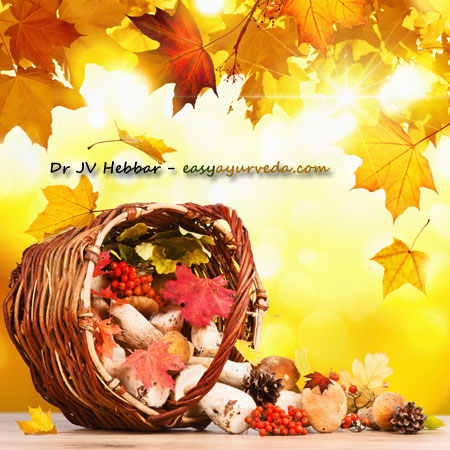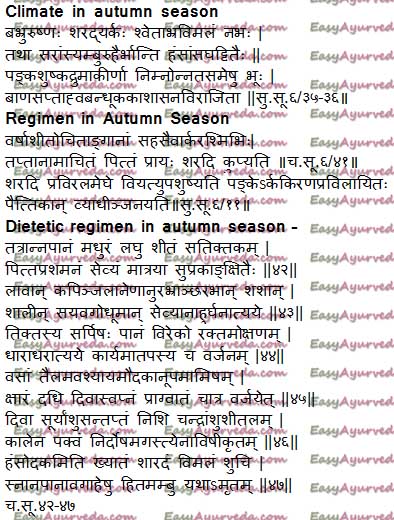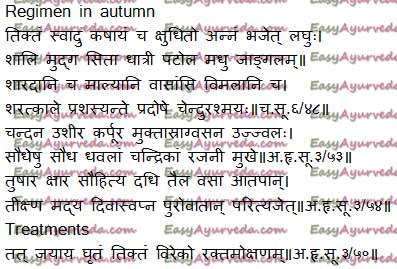Ayurvedic Health Tips For Autumn Season

Autumn is a very important season from health perspective. As per Ayurveda, Vata Dosha is decreasing gradually and Pitta is hitting its peak. Here are health tips for autumn.
Table of Contents
Pitta dosha in Autumn
How Pitta Dosha increases during Autumn:
During rainy season, one is accustomed to coldness. When the body is suddenly exposed to warm rays of Sun, the Pitta, which undergoes slight increase during rainy season gets aggressive.
Vata dosha in Autumn
Vata Dosha undergoes natural decrease. During rainy season, due to coldness (which is a Vata quality), Vata gets aggressive (that is why, pains and aches worsen during rainy season.) But due to hotter rays of autumn, Vata gets pacified.
Foods to have
In order to get over it, Tikta ghrita (medicated ghee recipe with bitter herbs) is specifically mentioned.
When hungry, the person should take foods which are of bitter, sweet and astringent tastes. These tastes are anti Pitta in nature.
Easily digestible foods such as rice, green gram, sugar, Amla, pointed gourd, honey are good to have.
Eat animals of desert-like lands
Goat meat, mutton, chicken, rabbit.
Rice , barley and wheat are fine to have.
Hamsodaka
The water which gets heated by the hot rays of the sun during day cooled by the cool rays of the moon during night, for many days continuously, which has been de-poisoned by the rise of the star Agastya, which is pure, uncontaminated and capable of mitigating morbid matters of the body, is known as Hamsodaka. It neither too moist to obstruct body channels, nor very dry. Such a water is nectar and should be used for drinking, bathing and cooking purposes.
Foods to avoid
Indulgence in Kshara (alkaline substances), satiation with a very heavy meal.
Sour curd should be avoided.
Muscle fat, use of curds, mustard oil should be avoided.
Strong liquors that cause Pitta increase should be avoided.
Fish and other aquatic animals should be avoided.
Ideal activities to follow
Virechana treatment – purgation therapy helps to expel Pitta out of the body.
Pitta is also related to Rakta (blood). Hence, if the blood is vitiated with Pitta, then blood letting should be done.
In some parts of India, for people with high blood pressure, blood letting therapy during autumn is performed, which keeps the pressure normal during the rest of the seasons as well.
Evening should be spent on the terraces of houses which are white (by painting), anointing the body with the paste of Sandalwood, Cus Cus grass, Camphor, wearing garlands of pearls and shining dress and enjoying the moonlight.
Use of garlands made of autumnal flowers and clean cloth and also the rays of the moon in the evenings are very beneficial.
Activities to avoid
Exposure to mist, sunlight,
sleeping at day time should be avoided. Because, the digestion strength is altered due to Pitta and napping will further disturb it.
Eastern breeze should also be avoided, as it brings heat waves.
Summary
Sharad Rtu Charya – autumn season regimen
In this season exposure of body to sudden heat of sun causes pitta aggravation. There will also be decrease in vata. Therefore one should follow regimen of this season properly and follow food and lifestyle practices so as to balance pitta and vata.
One should consume and follow below mentioned foods and lifestyle activities –
- Foods rich in sweet, bitter and astringent tastes, light in quality
- Sweet, bitter, light and cold, pitta pacifying foods shall be consumed
- Avoid fat, oil, mist, meat of marshy and aquatic animals, alkali, curds, day sleep
- Rice, barley and wheat may be consumed
- Water purified by sun rays in day and moon rays at night should be taken. This is called Hamsodaka.
- Clean clothes and garlands made up of seasonal flowers should be worn
- Mist, day sleep should be avoided
- Virechana shall be administered to expel morbid pitta, bloodletting too is preferred
Added by Dr Raghuram Y.S. MD (Ay) & Dr Manasa, B.A.M.S
Basics rules and regimen to be followed in autumn season
Category of Sharad season
Sharad Rtu, i.e. autumn season is the second season of the Visarga Kala or Dakshinayana i.e. Southern Solstice. It is preceded by Varsha Rtu i.e. rainy season, which happens to be the first season of southern solstice. Autumn season is followed by Hemanta Rtu i.e. early winter season, the last season of the southern solstice. Thus, autumn season is the middle and second season of southern solstice.
Features of Autumn season
Common for all seasons of Southern Solstice
Moon is predominant in this season.
In this season, like any other season of Southern Solstice, the Sun moves southwards.
This season gives strength to the person. This happens because of the reduced heat in comparison to the seasons of northern solstice and also since this season comes after the monsoon season. But there is comparatively more heat in this season in comparison to the other two seasons i.e. monsoon and early winter seasons of southern solstice.
The sun shines but not harder, there is heat, the sky is clear with white clouds.
The winds are present all through the southern solstice, autumn season is no exception.
Like other seasons of southern solstice, the moon is more powerful in comparison to the sun.
Sour, salt and sweet tastes are predominant in the food, plants, water and medicines. These three tastes increase the strength of an individual. These three tastes are antagonistic to vata. These three tastes enhance the water content of the body and keep the body hydrated. But in autumn, there is aggravation of pitta. Sweet taste is antagonistic to pitta. Therefore the foods and medicines having predominant sweet tastes shall be consumed to keep the pitta in control. Similarly, the pitta aggravating tastes i.e. sour and salt should be avoided.
Parallel to pitta aggravation, there is pacification of vata in autumn season.
Specific for autumn season
Zodiac / Rasi of the Sun in autumn season – Virgo i.e. Kanya Rashi and Libra i.e. Tula Rasi are the Zodiacs which fall into the autumn season.
Hindu Months (Saka varsa / masa) which constitute autumn season – According to Hindu calendar, Aashvija (Isha) month which extends from September 15 to October 15 & Karthika (Urja) month which extends from October 15 to November 15, fall in autumn season.
Calendar month and time period of autumn season – Sharad Rtu i.e. autumn season falls between September 15 and November 15.
Dosha status in autumn season – In autumn season, aggravation of pitta dosha takes place. We should remember that the pitta had undergone accumulation in the previous season i.e. rainy season. In rainy season pitta had not undergone aggravation in spite of availability of unctuousness etc factors which are favorable for its aggravation. This is because of the coldness in the climate which is antagonistic to pitta. Coldness prevents aggravation of pitta. In the next season i.e. autumn season, the unctuousness etc factors are associated with heat in the climate. Since all factors are favorable for the aggravation of pitta, pitta aggravates in autumn season. At the same time, vata which had undergone aggravation in the monsoon / rainy season will get pacified since unctuousness etc qualities, heat in environment and the salt taste predominantly present in the medicines and foods during this season are antagonistic to vata.
Strength (bala) of the person in autumn season – The person is said to have moderate strength in autumn season.
Predominant taste of autumn season – Lavana rasa i.e. salt taste is predominant in autumn season. This taste is made up of water and fire elements. Salt taste pacifies vata, increases pitta and kapha. While salt decreases vata in autumn season, it causes aggravation of pitta, which naturally tends to increase due to the effect of the season. Therefore foods and medicines predominant in salt tastes shall be avoided in autumn season.
The climate in autumn season –
In autumn season, the sun shines following stoppage of rains. The sun is hot and shines with coppery color. The sky is clear and is filled with white clouds. The ponds are filled with lotus leaves which are set to vibration by the touch of swans swimming in the ponds. The earth is filled with wt mud and ant hills. Flowering occurs in Terminalia arjuna, Strobilanthus ciliatus, Alstonia scholaris, Sesbania grandiflora and Pterocarpus marsupium plants.
Regimen in Autumn Season
During monsoon season, the body will be accustomed for coldness in the atmosphere. Sudden exposure to the heat of the sun rays in autumn season makes the body hot and aggravates pitta which has got accumulated in rainy season.
This also happens due to the reduction of clouds and increased intensity of sun rays. The wet mud gets dried by this and produces pitta disorders.
In the autumn season, there is aggravation of pitta dosha and also pacification of vata dosha. Due to the availability of unctuousness etc qualities, salt taste in foods and medicines and heat in the environment, pitta which has accumulated in the rainy season undergoes aggravation in autumn season.
Therefore, all regimens are targeted to combat and control the aggravated pitta. All food and life activities are planned accordingly.
To sum up, in autumn season, all the measures, medicines, foods and therapies should be oriented towards mitigating and expelling the aggravated pitta.
Dietetic regimen
In autumn season, one should consume sweet, bitter, light, cold and pitta alleviating foods in proper quantities. Foods having bitter, sweet and astringent tastes which are light to digest should be consumed in autumn season, only after feeling hungry.
The below mentioned are beneficial foods in autumn season –
- processed meat of common quail, grey partridge, ena deer, rabbit, sheep
- shali variety of rice,
- barley and
- wheat
- green gram
- sugar candy
- Indian gooseberry
- snake gourd
- honey
- meat of animals and birds living in desert-like lands
The below mentioned foods may be avoided during autumn season –
- fat and muscle fat
- oils
- meat of marshy animals
- meat of aquatic animals
- alkali
- curds,
- strong alcoholic preparations

Other Regimens, Activities and therapies
During autumn season, one should follow the below mentioned regimen –
- wearing the garlands made up of seasonal flowers blooming in autumn season
- clean clothes should be worn
- one should apply paste of sandalwood, vetiver, garlands of pearls and clean clothes and sit over the terrace of the house which has been white washed and enjoy the moon light in the first part of the night, the moon rays in the first three hours of the night is conducive for health
- one should enjoy the cold breeze at night even in the krshna paksha i.e. dark lunar fortnight / waning moon
During autumn season, one should avoid the below mentioned –
- sleeping during daytime
- exposure to east winds
- mist
- alkalis
- excessive eating
Treatments –
The aggravated pitta should be expelled by administering therapeutic purgation and bloodletting, after having subjected the patient to snehapana i.e. metered drinking of medicated fats with bitter ghee. These treatments should be administered at the end of monsoon season i.e. at the beginning of autumn season.

Managing Rtu Sandhi
Like all other seasons, the autumn season too runs to a period of 2 months. Rtu Sandhi is junction period between two seasons. It constitutes a time period of 14 days.
Autumn season shares two season junctions, one with its previous season and the other with its succeeding season.
Seasonal junction with rainy / monsoon season i.e. previous season, the Varsha-Sharad Rtu Sandhi
The immediate previous season for Sharad Rtu is Varsha Rtu i.e. rainy season. This is the first season of Southern Solstice. The seasonal junction between the rainy season and autumn season comprises of the last 7 days of rainy / monsoon season and first 7 days of autumn season. In this period, the regimens of rainy season should gradually be discontinued and the regimens of autumn season should be gradually practiced.
Seasonal junction with early winter season i.e. upcoming season, the Sharad-Hemanta Rtu Sandhi
The immediate next season for Sharad Rtu is Hemanta Rtu i.e. early winter season. This is the third and last season of Southern Solstice. The seasonal junction of autumn season with early winter season is the last 7 days of autumn season along with the first 7 days of early winter season put together. In this period, the regimens of autumn season should gradually be discontinued and the regimens of early winter season gradually practiced and adapted. This enables one to get ready to enter into another season and get adapted to it easily. Sudden change in regimes may produce many diseases due to asatmya i.e. incompetence. Therefore the changes need to be done gradually.
Click to Consult Dr Raghuram Y.S. MD (Ayu) – Email / Skype
Opinion of Sushruta
During Autumn season, the sun rays are brownish and hot, sky has white clouds and is clear; the ponds and lakes are full of lotus flowers and herds of swans; the ground has dried slush, dry trees and elevation and depressions; bana, saptahva, bandhuka, kasa and asana adore the land.
Blood donation
How Can Blood Donation Therapy help with hypertension?
As per Ayurveda, every healthy individual has to undergo seasonal detoxification (Panchakarma) to keep the body free from disease causing toxins.
High BP is associated with blood tissue, which in turn, is related with Pitta Dosha. Blood tissue and blood pipes are directly controlled by Pitta Dosha.
Read: Hypertension: Causes, Symptoms, Ayurvedic Treatment
Pitta Dosha naturally increases in all of us during Autumn season (September end to November). During this season, Virechana – purgation therapy is advised to everyone, to keep Pitta under balance. Virechana expels toxic Pitta out of the body. Similarly, blood letting is also useful in expelling out Pitta Dosha from the body. Blood tissue related diseases such as hypertension, bleeding disorders, allergies such as repeated hives, chronic skin diseases such as psoriasis are immensely benefited by blood letting therapy.
If you are averse to get blood-letting therapy in an Ayurveda center, you can easily donate your blood once a year, during autumn season. Though blood donation is not exactly equivalent to blood-letting therapy, it is useful to some extent for sure.
For this reason, many healthy people are advised to donate blood by their Ayurvedic doctors. For all healthy people, blood donation, at least once a year is good. It improves your health and also saves someone else’s life. Then why not do it in Autumn season?
Note: This applies only to healthy people. For patients, it is advised to go with the advice of your consulting doctors. There are several conditions such as low hemoglobin levels, viral hepatitis, etc., where blood donation is contra indicated.










8 comments
Sophie Hawkins
In Canada, the spring is very rainy and the fall is more cold and dry-in the autumn the leaves turn colour and then dry and fall off the trees and then we go into winter. More like in the Himalayas in India. So in Canada I think of the spring needing to balance cold and damp and the fall balancing cold and dry. Thanks again for all your helpful blogposts!
Dr J V Hebbar MD(Ayu)Author
Hi, like you have mentioned, the Ayurvedic seasonal regimen explained needs to be understood subjectively based on the different climatic conditions of different seasons.
In Whichever country one may live, If it is too cold –
Cold weather – winter regimen – https://www.easyayurveda.com/2014/09/07/ayurvedic-health-tips-for-winter-season/
Couple of months after cold season – https://www.easyayurveda.com/2014/09/09/ayurvedic-health-tips-spring-season/
Very hot – summer regimen – https://www.easyayurveda.com/2014/09/13/ayurvedic-health-tips-for-summer-season/
If it is raining continuously – https://www.easyayurveda.com/2011/06/01/19-ayurveda-health-tips-for-rainy-season/
Sunny season that falls after rainy season – https://www.easyayurveda.com/2014/09/13/ayurvedic-health-tips-for-autumn-season/
Sejal
Hi, Thank you for the insightful articles. What reading article would you recommend for the upcoming Fall Months where in the USA the weather turns cold dry and windy? thank you
Dr J V Hebbar MD(Ayu)Author
Hi, hope this article helps – https://www.easyayurveda.com/2014/09/13/ayurvedic-health-tips-for-autumn-season/
Dr. amit malik
Dr Hebbar I think some part of advise is not practicable in present day life-style. The essence of text should be converted according to modern life-style so a common man find some persuasion in following advise.
Dr J V Hebbar MD(Ayu)Author
Hi, I try my best to do that. Sometimes I win and sometimes I fail.
If you can point out and simplify things, the readers will be benefited.
mia
Hi Dr Hebbar,
I always read ur articles with great interest n find them truly informative. we have faith in Ayurveda, n credit our good health to avoiding allopathic medicine. Sometimes Indians r located overseas n the seasonal conditions may be difficult to assess. So many of the uninitiated will simply balk at expressions such as ‘ blood letting ‘ Also if links could be provided in d articles to further clarifications, it would facilitate a better n deeper understanding of this ancient Indian science.. Will share ur articles, let the readers have d wisdom to choose.
Thanks
Regards
Mia
Dr J V Hebbar MD(Ayu)Author
Dear Mia, thanks for your concern and suggestion. Will surely implement. But I am yet to write in detail about blood letting, which is still an incredible way of treating many diseases.